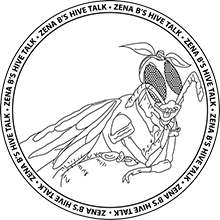Hive Talk - September 2020
Hive Talk Sept 2020

Zena Bees - Hive Talk September 2020
This summer has been another learning curve for me. You can read all the books in the world about bees, of which I haven’t, but am trying to, and still do not see the obvious. Hands on is my best teacher.
We have two hives... On July 24th, we did an extraction and only packaged 43 lbs of honey. We only took the honey from one hive, and left the other because it was the weaker colony. The reason I say that it was a weaker hive was that when we picked up our bees it was in the middle of the afternoon when all the foragers from that colony (nuc - 5 frames of food, and brood, and the queen in a transportable container) were out collecting nectar and pollen. The apiary closed up the ‘nuc’ with only half the colony and had it ready for pick up. (Lesson One)…..pick up your nucs first thing in the day so that the bees are packaged early and ready for pickup before they head out for the day.
On August 20th, we did another extraction from the other hive and only packaged 54 lbs of honey. This hive was left to fill the honey supers for a longer period of time than the first one. Some of the honey was starting to crystallize so I extracted what I could. (Lesson Two - extract more often and don’t wait until all of the cells have been capped. I have a device that measures the moisture content in the honey just to make sure that it is at an optimal 18% moisture, anything less warrants crystallization. Especially for canola nectar.)
I did an inspection shortly after the last extraction and couldn’t find the queens. There was no brood, no eggs, and no larvae. Emergency!!! Had I opened up the hives more frequently I could have intercepted this problem, introduced new queens, and built up the colonies before winter. (Lesson Three- continually inspect the hives every 10 days to ensure that the queen is doing her job, as you will constantly see new brood, eggs, larvae present. If not, you will run into missing generations of young bees that are an essential to maintaining a thriving community. You need the nurse bees who are 3-10 days old to tend to the larvae babies. At that age the nurse bees are the only one capable of creating an enzyme that they add to the pollen and honey, which is called ‘bee bread’, to feed the developing brood. If you have missed a generation, or two, of this caste you may as well start over again if it is later on in the season. If you have a thriving colony and a weak colony you could combine the two and ‘pinch’ the queen of the weaker colony.)
I contacted Janeil’s Honey, a large apiary ‘buzz’iness located just outside of Eatonia, SK, and asked if they had any available queens for sale. Neil was in the process of splitting his hives and installing new mated queens to his new colonies. He had two extra queens, and delivered them on the way to Medicine Hat. He also took his time to inspect my hives and give VALUABLE information to help me and the bees into the fall and winter months. Maybe the bee spirit was on my side as Neil’s truck broke down and he was somewhat stranded until his wife picked him up! Thank you Neil!
I installed the queens; they were accepted, and the last inspection produced eggs, and larvae. (Lesson Four - queen installation) But am I too late? Will the bees be able to produce enough workers to sustain a healthy hive over the winter months?
Time will tell. I will inspect the hives internally by taking the frames out, for inspection of both the top and bottom brood boxes. (Lesson Five - should have been doing this all along instead of checking the brood’s population externally.)
I am most certain there will be more lessons to learn about these fascinating creatures in the years to come. I am enjoying the wonderful world of bees and will continually try my best to keep them healthy and productive in the years to come.
Next month I’ll chat more about bees! …..and next month! Stay safe and BEE there for each other. Zenabshoney.com
